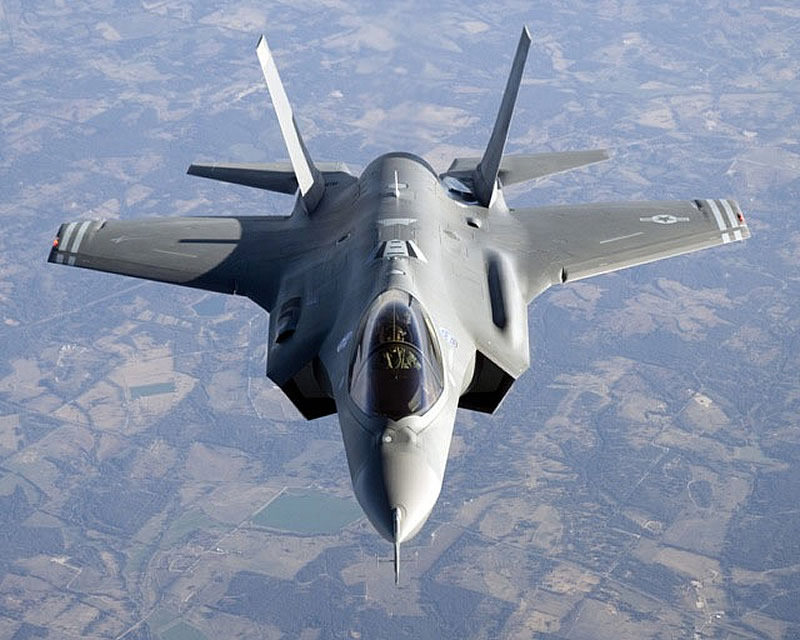THE F-35 STEALTH FIGHTER PROGRAM: How the War Economy Contributes to Exacerbating the Social Crisis

There is mounting controversy regarding the purchase of the F-35 stealth fighter jet from US defence giant Lockheed Martin. The Pentagon has commissioned the purchase of 2,443 aircraft “to provide the bulk of its tactical airpower for the US Air Force, Marine Corps and Navy over the coming decades”. This massive procurement of advanced weapons systems is part of America’s “Global War”, largely directed against China, Russia, North Korea and Iran.
The overall cost of the program to the US military is estimated at a staggering $1.51 trillion over the so called life cycle of the program, namely $618 million per plane. (Shalal-Esa, Andrea. Government sees lifetime cost of F-35 fighter at $1.51 trillion., Chicago Tribune, April 2, 2012).
Several of America’s close allies including the UK, Australia, Italy, Canada, the Netherlands, Norway, Turkey, Israel, and Japan are slated to purchase the F-35 stealth fighter plane.
The economic and social implications of this program are potentially devastating. Apart from the fact that the fighter planes will be used in upcoming US-NATO wars, resulting in inevitable civilian deaths, their procurement –at tax payers expense– will contribute to exacerbating the ongoing fiscal crisis. Unless they are solely funded by an increase in the public debt (which is highly unlikely), these massive expenditures on advanced weapons systems will require the adoption of concurrent austerity measures over a period of up to thirty years, at the expense of an entire generation.
The costs of military procurement are always at the expense of social programs, public investment in infrastructure and employment creation in the civilian economy. Conversely, very few jobs will be created by the defence contractors. The cost of creating one job in America’s weapons industry (2001) varies between 25 and 66 million dollars per job. (Michel Chossudovsky, War is Good for Business, Global Research, September 2001)
In the US and NATO member countries, drastic budgetary measures are currently being applied with a view to financing the “war economy”. These economic measures –adopted at the crossroads of a Worldwide economic depression– are also contributing to spearheading entire national economies into bankruptcy, with devastating social consequences.

Canada’s F-35 Program
In Canada, the Conservative government had initially committed itself to an overall cost of the F-35 stealth fighter program of 9 billion dollars involving the purchase of 65 aircraft. This figure of 9 billion dollars was a political cover-up. Known and documented, the real cost of the program was much larger. Auditor-General Michael Ferguson’s report presented to the House of Commons (April 2), confirmed that the cost of Canada’s F-35 programme “could reach $30 billion over three decades”, namely $461 million per plane:
“In March 2011, the Parliamentary Budget Officer (PBO) provided Parliament with a report on the estimated acquisition and sustainment [sic] costs associated with Canada’s planned purchase of 65 F-35 fighter jets. Shortly thereafter, the Department of National Defence (DND) responded to the PBO report. In that response, DND claimed that the total costs associated with the F-35 program would be approximately $15 billion. However, the recent auditor general’s report reveals that, in June 2010, DND’s true cost estimate was approximately $25 billion — representing a difference of $10 billion. The inclusion of this difference would bring DND’s cost estimate in line with that of the PBO,”
It is worth noting that the estimated unit cost in Canada’s program ($461 million per aircraft) which has been the object of political controversy is substantially lower than that of the US (estimated at $661 million) and Norway (estimated to be of the order of $769 million over the “operational lifetime” of the F-35 aircraft). (Testimony of Rear Admiral Arne Røksund, “41st Parliament, 1st Session, Standing Committee on National Defence.”, House of Commons, Ottawa, November 24, 2011).
Ottawa’s 2012 Austerity Budget
Careful timing: The 30 billion dollar cost of the F-35 programme was known prior to the presentation of the budget. The report of Canada’s Auditor General (April 3), however, regarding the cost overrun was only made public ex post facto, five days after the budget speech by Finance Minister Flaherty on March 29.
The 2012 Canadian federal budget presented a gruesome scenario of austerity measures requiring massive layoffs of federal government employees, drastic cuts in spending including pension funds and the curtailment of federal provincial transfers. In contrast, the issue of spiralling defense spending resulting from the F-35 fighter program is not acknowledged, as if it has no bearing on the structure of public expenditure.
The government had announced drastic austerity measures, but these budgetary measures apply largely to non-military spending. (The federal budget estimates indicate a modest cut in defence expenditure, which do not include predictable overruns in the cost of weapons procurement).
The crucial question: How does this multibillion dollar F-35 project affect the 2012 federal budget, which is largely predicated on a sizeable curtailment of “civilian” as opposed to “military” expenditures?
The issue of the budget deficit could be resolved overnight by reining in the war economy. But that “solution” would not be in the interest of achieving “World peace” and “global security”.
“Guns versus Butter”: How does this spiralling defence expenditure allocated to the purchase of advanced weapons systems affect all other categories of civilian government expenditure? How does it affect public investment in the civilian economy?
These questions are of crucial significance for the people of the United States, whose government is spending a staggering $1.5 trillion on the F-35 program. It has similar implications for the nine countries which decided to purchase these expensive fighter planes, while concurrently implementing “strong economic medicine” to finance the predictable cost overruns of military spending.
“War is good for business” (for the defence contractors) yet at the same it spearheads the civilian economy into bankruptcy.
Nowhere in the Canadian federal budget is the issue of the F-35 program and its staggering overall cost of 30 billion dollars mentioned. That’s an average cost of $461 million dollars per plane, including the “flyaway” purchase plus the so-called sustainment costs (maintenance, operating costs and related investments associated with the F-35 program).
Canada’s Welfare State is collapsing, health care is in the process of being privatised, primary and secondary education is under-funded. Universities are in a state of crisis with rising tuition fees. Yet at no point in the debate on the 2012 federal budget has the issue of the war economy been raised.
How does the war economy backlash on people’s lives? How does it undermine and destabilize the civilian economy? How does it affect the funding of social programs?
What should be understood is that the austerity measures are in part implemented with a view to financing the war economy.
The Protest Movement
The protest movement against the economic austerity measures must be integrated be with the antiwar movement.
The abolition of war –including the closing down of the weapons industry– is a precondition for scrapping the neoliberal economic agenda. War and Globalization are intimately related.
University students in Quebec have recently been involved in mass demonstrations regarding the hike of tuition fees implemented by the provincial government. Yet at no time has the issue of military spending and its impact on social programs been raised.
The purchase of advanced weapons systems will inevitably be at the expense of federal provincial transfers which contribute to the financing of health and education.
Curtailing the F-35 stealth fighter program would immediately make more money available in support of Quebec’s university students. In fact the cost associated with one F-35 fighter plane (461 million dollars) would release more than enough resources to finance the hike in tuition fees for years to come.
The protest movement against government austerity measures applied in the US, Canada and the European Union must address the issue of the US-NATO led war.
The F-35 stealth aircraft are not weapons of peace. They are part of the killing machine. They are slated to be used against China, Russia, Iran and North Korea.
They are “weapons of mass destruction” to be used in the Pentagon’s “long war”.
The other side of the coin pertains to “Guns versus Butter”, namely the relationship between the “civilian economy” and the “war economy”.
War and the neoliberal economic policy agenda are part of an integrated process.
The staggering cost of these advanced weapons is contributing to the demise of what is left of the Welfare State, not to mention the impoverishment –in several NATO member countries– of an entire generation.


